- 350 people from the Miyakoji district of Tamura city will be allowed to head home
- 20-kilometer (12-mile) exclusion zone declared around crippled nuclear plant since 2011
- Devastating earthquake and tsunami knocked out the Fukushima nuclear plant
- Many residents remain concerned about radiation levels despite decontamination efforts
(CNN) -- Japan's government is to allow some residents around the crippled Fukushima nuclear plant to return to their homes to live for the first time since the March, 2011 disaster.
Tens of thousands of people were evacuated and a 20-kilometer (12-mile) exclusion zone declared around the plant after a devastating earthquake and tsunami triggered a reactor meltdown -- the world's worst nuclear disaster since Chernobyl in 1986 -- causing high levels of radioactive contamination.
Once bustling communities in this pocket of eastern Japan were turned into ghost towns.
Google Street View maps Fukushima nuclear ghost town
But on April 1, some 350 people from the Miyakoji district of Tamura city will be allowed to head back to their homes permanently, according to the country's Reconstruction Agency. Some 31,000 people could eventually return home, it added.
 See inside Japan's damaged nuclear plant
See inside Japan's damaged nuclear plant 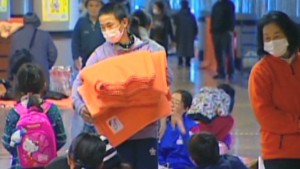 The children of Fukushima
The children of Fukushima 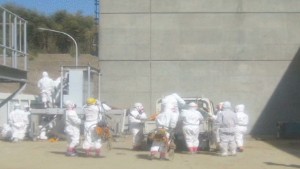 Nuclear plant workers claim mistreatment
Nuclear plant workers claim mistreatment The government says about 138,000 Fukushima residents are still living in temporary accommodation.
At a meeting Sunday, Miyakoji residents were told that radiation contamination levels had lowered sufficiently for their return to the area -- though some voiced concern over existing radiation levels despite decontamination efforts around some communities.
Life goes on despite uncertainty in Fukushima region
Areas are declared suitable for habitation if residents are exposed to a maximum of 20 millisieverts of radiation per year. Officials have said they would like to get radiation exposure down to one millisievert a year.
Fukushima leaks
The containment effort at the wrecked Fukushima-Daichi plant has been beset by problems, with regular reports of leaks of contaminated material. Last week, an estimated 100 metric tons of highly contaminated water flowed over a barrier around a containment tank and is being absorbed into the ground, plant operators, Tokyo Electric Power Company (TEPCO), said in a statement -- though it denied there was any leakage into the nearby Pacific Ocean.
Prime Minister Shinzo Abe's government vowed to step in to deal with the toxic water crisis at the plant that caused concern in Japan and abroad about the scale of the problem faced by TEPCO.
The leak reported Thursday is one of the largest since TEPCO reported last summer that about 300 tons of radioactive water had leaked from a tank.
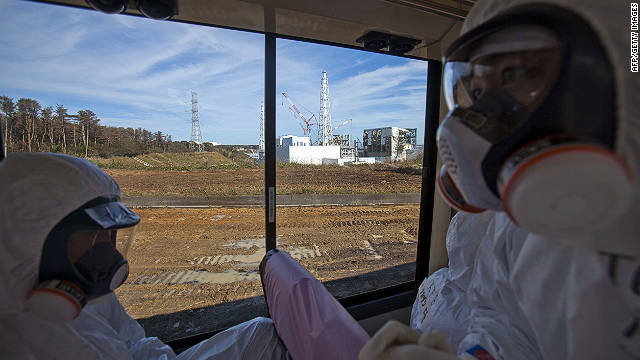 People wearing protective suits and masks ride on a bus past the crippled Fukushima Daiichi nuclear power station in Okuma, Japan, on Saturday, November 12 2012. Journalists got their first ground-level glance around the stricken facility, eying shells of reactor buildings, tons of contaminated water, and workers still scurrying to mitigate damage from a crisis that began eight months ago.
People wearing protective suits and masks ride on a bus past the crippled Fukushima Daiichi nuclear power station in Okuma, Japan, on Saturday, November 12 2012. Journalists got their first ground-level glance around the stricken facility, eying shells of reactor buildings, tons of contaminated water, and workers still scurrying to mitigate damage from a crisis that began eight months ago. 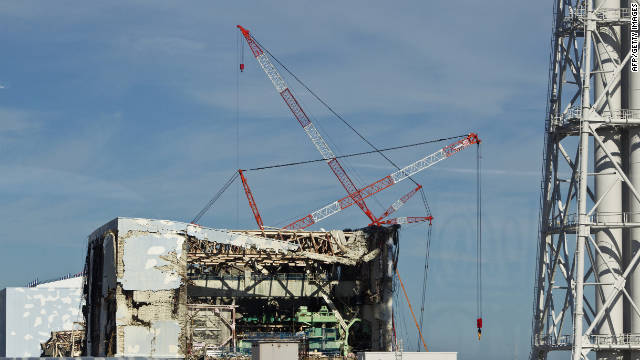 The crippled Fukushima Daiichi nuclear power station is seen through a bus window in Okuma on Saturday. An epic 9.0-magnitude earthquake and subsequent tsunami March 11 wreaked havoc around Japan, killing more than 15,000 people. While many of those died instantly, the East Asian nation was on edge for weeks as utility and government employees scrambled to prevent a worsening nuclear catastrophe at the Daiichi plant, located about 150 miles (240 kilometers) north of Tokyo.
The crippled Fukushima Daiichi nuclear power station is seen through a bus window in Okuma on Saturday. An epic 9.0-magnitude earthquake and subsequent tsunami March 11 wreaked havoc around Japan, killing more than 15,000 people. While many of those died instantly, the East Asian nation was on edge for weeks as utility and government employees scrambled to prevent a worsening nuclear catastrophe at the Daiichi plant, located about 150 miles (240 kilometers) north of Tokyo. 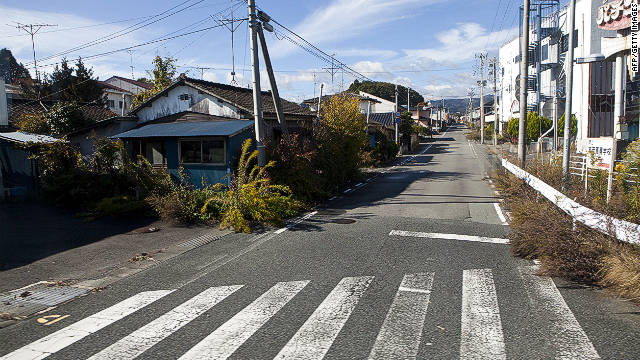 A deserted street near Okuma is visible from the bus window, inside the contaminated exclusion zone near the crippled nuclear power station.
A deserted street near Okuma is visible from the bus window, inside the contaminated exclusion zone near the crippled nuclear power station.  Throughout the summer and fall, there were no longer reports of explosions or new leaks of radioactive material into the ground and sea. But the facility still remained off limits to reporters and, for a 20-kilometer radius around the plant, to the general public, due to the continued high levels of radiation and ongoing efforts to prevent yet more blasts and leaks.
Throughout the summer and fall, there were no longer reports of explosions or new leaks of radioactive material into the ground and sea. But the facility still remained off limits to reporters and, for a 20-kilometer radius around the plant, to the general public, due to the continued high levels of radiation and ongoing efforts to prevent yet more blasts and leaks. 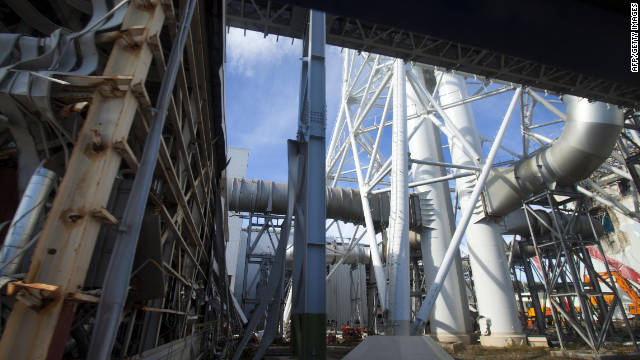 Radiation readings rose steadily as the journalists neared the plant, reaching 6.7 microsieverts in Okuma. There, they put on respirator masks, adding to an ensemble of a protective suit, two pairs of gloves, two sets of plastic booties over their shoes and a radiation detector.
Radiation readings rose steadily as the journalists neared the plant, reaching 6.7 microsieverts in Okuma. There, they put on respirator masks, adding to an ensemble of a protective suit, two pairs of gloves, two sets of plastic booties over their shoes and a radiation detector. 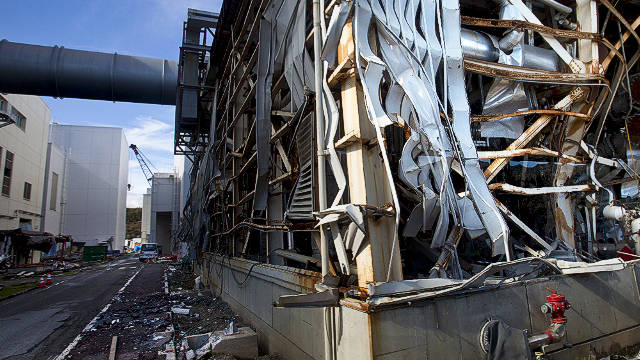 The crippled Fukushima Daiichi nuclear power station is visible through a bus window Saturday.
The crippled Fukushima Daiichi nuclear power station is visible through a bus window Saturday. 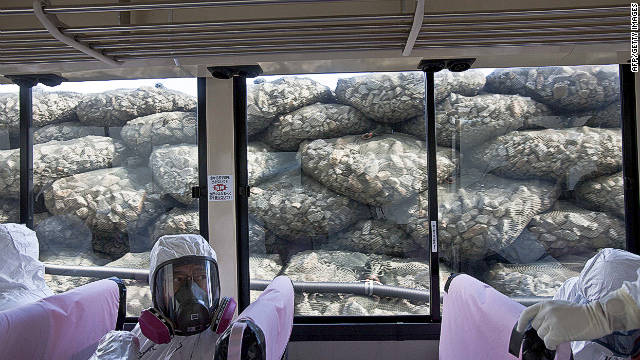 Journalists pass a newly built sea wall next to the crippled nuclear power station.
Journalists pass a newly built sea wall next to the crippled nuclear power station. 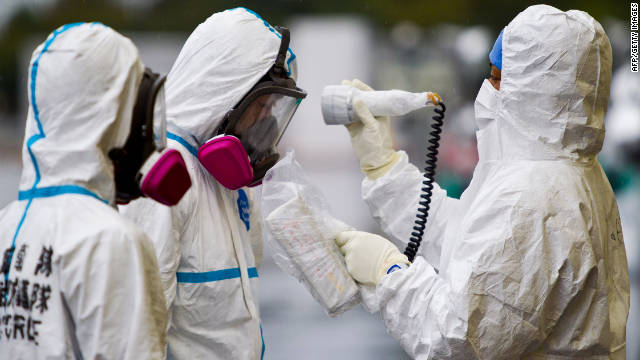 Workers dressed in protective suits and masks are checked for radiation outside a building at J-Village, a soccer training complex now serving as an operation base for those battling Japan's nuclear disaster in Fukushima.
Workers dressed in protective suits and masks are checked for radiation outside a building at J-Village, a soccer training complex now serving as an operation base for those battling Japan's nuclear disaster in Fukushima.  A employee of the Tokyo Electric Power Company walks up stairs near temporary housing built for workers who live at J-Village, at the former soccer training complex.
A employee of the Tokyo Electric Power Company walks up stairs near temporary housing built for workers who live at J-Village, at the former soccer training complex. 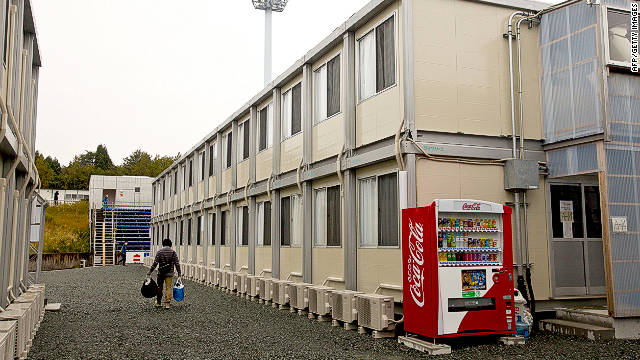 A worker carries his belongings as he walks among the temporary housing structures at J-Village.
A worker carries his belongings as he walks among the temporary housing structures at J-Village. 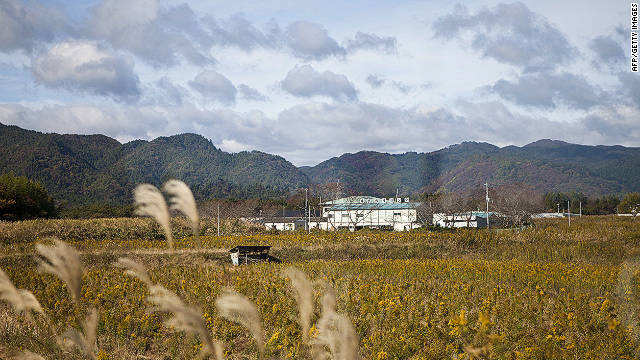 A deserted field and buildings inside the contaminated exclusion zone around the crippled nuclear power station are seen through the bus window.
A deserted field and buildings inside the contaminated exclusion zone around the crippled nuclear power station are seen through the bus window. 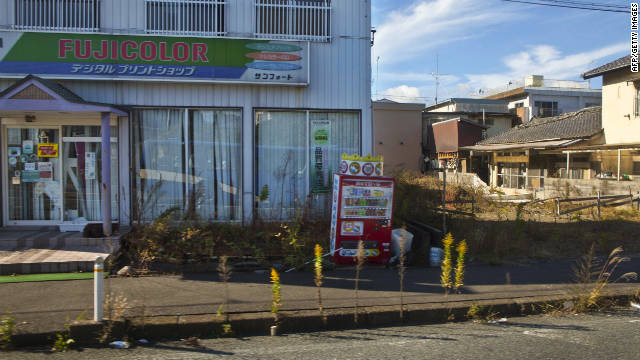 A deserted neighborhood inside the contaminated exclusion zone is visible through the bus window.
A deserted neighborhood inside the contaminated exclusion zone is visible through the bus window. 











No comments:
Post a Comment